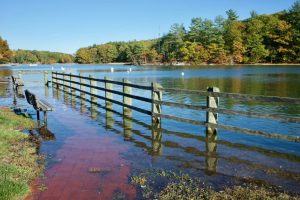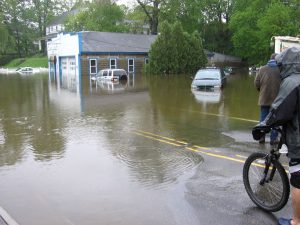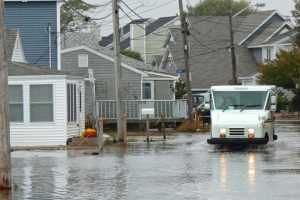By: Lisa Graichen

Durham, King Tide, 2016 (credit: Todd Selig)
Concord, NH – Two recent policy developments in New Hampshire support preparedness and planning for sea-level rise, storm surge, and extreme precipitation. Both advance recommendations from the NH Coastal Risk and Hazards Commission, outlined in the Commission’s final report, Preparing New Hampshire for Projected Storm Surge, Sea-Level Rise, and Extreme Precipitation (2016).
Senator Watters introduced Senate Bill 185, which extends the community revitalization tax relief program (RSA 79-E) to coastal properties subject to storm surge, sea-level rise, and extreme precipitation. The bill had bipartisan support from co-sponsors Senators Fuller Clark and Innis and Representatives Chase, Cushing, and Ward, and it was signed by Governor Sununu. The new law enables municipalities to designate Coastal Resilience Incentive Zones (CRIZ) and use tax abatements and other incentives to support preparedness.
It is first-in-the-nation legislation. It provides great flexibility for municipalities to determine resilience measures, such as, but not limited to, elevation and free-board renovations, elevation of mechanicals, construction of resilient natural features, enhancement or creation of tidal marshes, elevation of private driveways and sidewalks, construction or enlargement of private culverts and other structures to enable increased water flow and storm-surge, and movement of property to higher elevation on the property or to a newly acquired property at a higher elevation within the municipality. These practical efforts will lead to lower insurance costs and higher property valuations and a stronger tax base. – Senator David Watters, Fosters.com
Read the full text of SB 185 here and an informative article by Senator Watters here. This bill was approved July 5, 2017, and takes effect September 3, 2017. If your municipality has questions about implementing a CRIZ, NHCAW members are happy to help connect you with the answers you need. Just CAW-ntact us!

Newmarket flooding (credit: Rob Roseen)

King Tide 2016 (credit: Mike Barron)
In addition to SB 185, new N.H. Department of Environmental Services Alteration of Terrain (AOT) rules require consideration of sea-level rise, storm surge, and extreme precipitation in coastal areas. The new rules, effective August 15, 2017, add the requirement below that applicants submit the following with their applications:
(l) If the project is for infrastructure having a projected life that extends beyond 2050 and is within the coastal or great bay region, such additional information as is necessary to address projected storm surge, sea-level rise, and precipitation events identified in the 2014 Science and Technical Advisory Panel Report, Sea-Level Rise, Storm Surges, and Extreme Precipitation in Coastal New Hampshire: Analysis of Past and Projected Future Trends, prepared by the Coastal Risks and Hazards Commission and available at http://www.nhcrhc.org/stap-report/
Read the full text of the new AOT rules here.
NHCAW thanks the NH legislators for supporting policies that will incentivize and improve coastal communities’ preparedness for the impacts of climate change, and for continuing to build on the bipartisan work of the NH Coastal Risk and Hazards Commission.
